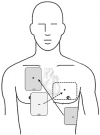Orthogonal electrical cardioversion in atrial fibrillation refractory to biphasic shocks: a case series
- PMID: 33442616
- PMCID: PMC7793132
- DOI: 10.1093/ehjcr/ytaa343
Orthogonal electrical cardioversion in atrial fibrillation refractory to biphasic shocks: a case series
Abstract
Background: Biphasic waveform shock has been established as the standard method for cardioversion of atrial fibrillation (AF). Depending on various factors, standard electrical cardioversion for AF may be unsuccessful in some cases, even with biphasic shocks.
Case summary: We report the safety and efficacy of orthogonal electrical cardioversion (OECV) as an alternative in patients with paroxysmal AF refractory to standard biphasic electrical cardioversion after up to three subsequent shocks of increasing energy and/or two or three initial shocks with maximum energy of 200-Joules. Shocks were delivered with two external defibrillators via two sets of adhesive electrode pads to apply two perpendicular electrical vectors in a simultaneous-sequential mode in antero-lateral and antero-posterior configuration. Five patients, mean age 54.4 ± 11, three with hypertensive heart disease and a body mass index 27.2 ± 2 kg/m2. All individual mean impedance before OECV was 79 ± 5 Ω with a mean peak current applied of 22 ± 4.5 A. Restoration of sinus rhythm with OECV was achieved acutely and sustained in all five patients. No patients developed haemodynamic instability or thromboembolic events.
Discussion: Double simultaneous shocks in an orthogonal configuration could theoretically decrease the defibrillation threshold through the ability of sequential pulses applying a more efficient and uniform current density. OECV using lower/medium energy may be another useful rescue strategy in AF refractory to standard biphasic shocks.
Keywords: High-energy cardioversion; Biphasic waveform shock; Case series; Double simultaneous shocks; Electrical cardioversion; Refractory atrial fibrillation; Transthoracic impedance.
© The Author(s) 2020. Published by Oxford University Press on behalf of the European Society of Cardiology.
Figures
Similar articles
-
[Impact of electrical shock waveform and paddle positions on efficacy of direct current cardioversion for atrial fibrillation].Medicina (Kaunas). 2008;44(9):665-72. Medicina (Kaunas). 2008. PMID: 18971603 Clinical Trial. Lithuanian.
-
[Double sequential electrical transthoracic shocks for refractory atrial fibrillation].Arch Cardiol Mex. 2005 Jul-Sep;75 Suppl 3:S3-69-80. Arch Cardiol Mex. 2005. PMID: 16366172 Spanish.
-
External cardioversion of atrial fibrillation: comparison of biphasic vs monophasic waveform shocks.Europace. 2001 Apr;3(2):96-9. doi: 10.1053/eupc.2001.0156. Europace. 2001. PMID: 11333061 Clinical Trial.
-
Internal defibrillation: where we have been and where we should be going?J Interv Card Electrophysiol. 2005 Aug;13 Suppl 1:61-6. doi: 10.1007/s10840-005-1824-6. J Interv Card Electrophysiol. 2005. PMID: 16133857 Review.
-
Techniques improving electrical cardioversion success for patients with atrial fibrillation: a systematic review and meta-analysis.Europace. 2023 Feb 16;25(2):318-330. doi: 10.1093/europace/euac199. Europace. 2023. PMID: 36503970 Free PMC article.
Cited by
-
A Systematic Review of the Transthoracic Impedance during Cardiac Defibrillation.Sensors (Basel). 2022 Apr 6;22(7):2808. doi: 10.3390/s22072808. Sensors (Basel). 2022. PMID: 35408422 Free PMC article.
References
-
- Page RL, Kerber RE, Russell JK, Trouton T, Waktare J, Gallik D. et al. Biphasic versus monophasic shock waveform for conversion of atrial fibrillation: the results of an international randomized, double-blind multicenter trial. J Am Coll Cardiol 2002;39:1956–1963. - PubMed
-
- Inácio JF, da Rosa Mdos S, Shah J, Rosário J, Vissoci JR, Manica AL. et al. Monophasic and biphasic shock for transthoracic conversion of atrial fibrillation: systematic review and network meta-analysis. Resuscitation 2016;100:66–75. - PubMed
-
- Kerber RE, Martins JB, Kienzle MG, Constantin L, Olshansky B, Hopson R. et al. Energy, current, and success in defibrillation and cardioversion clinical studies using an automated impedance-based method of energy adjustment. Circulation 1988;77:1038–1046. - PubMed
-
- Kerber RE, Grayzel J, Hoyt R, Marcus M, Kennedy J.. Transthoracic resistance in human defibrillation. Influence of body weight, chest size, serial shocks, paddle size and paddle contact pressure. Circulation 1981;63:676–682. - PubMed
-
- January CT, Wann LS, Alpert JS, Calkins H, Cigarroa JE, Cleveland JC Jr. et al. 2014 AHA/ACC/HRS guideline for the management of patients with atrial fibrillation: a report of the American College of Cardiology/American Heart Association Task Force on Practice Guidelines and the Heart Rhythm Society. J Am Coll Cardiol 2014;64:e1–e76. - PubMed
LinkOut - more resources
Full Text Sources


